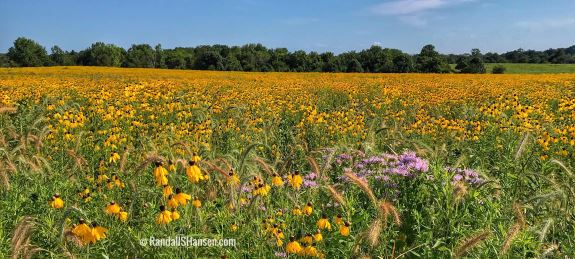
From Michigan, we did a counterclockwise circle of Indiana and Illinois, stopping first in Bluffton, just outside Fort Wayne, Indiana.
Indiana, the 26th state we have visited, means Land of the Indians (though not anymore) and is known as the “Crossroads of America,” because of the importance of waterways, railroads, highways, and other transportation facilities in the state. Interestingly, Indiana has more interstate highways per square mile than any other state… and more major highways intersect in Indiana than in any other state. It’s also known as the “Hoosier State.”
Forester Ran also has to share this fun fact: More than 100 species of trees are native to Indiana, and prior to colonization, about 80 percent of the state was covered with forest. Now only 17 percent of the state is considered forested… much more of it is covered in corn and soybean — the state’s most valuable farm products. Indiana is one of the top five states in the harvesting of corn and soybeans. Interestingly, hogs are the state’s most valuable livestock product.
We stayed at the Bluffton KOA, located just outside of town — which allowed us to unload our bikes and ride to a local trail: the River Greenway Trail. The Rivergreenway begins at Wabash River Park just a block north of City Hall in downtown Bluffton and winds along the beginnings of the Wabash River for two and a half miles, running parallel to East River Road, and ending at the White Bridge Picnic Area… almost connecting to another trail that leads to Ouabache State Park. The trail is mostly flat and an enjoyable ride — or walk. We encountered numerous folks walking along the trail.
Our main goal for riding the trail, though, was visiting Ouabache State Park — which is accessible by bike on a neat little trail on the east side of White Bridge. Located about 5 miles southeast of town, it is also accessible by car, but the distance makes it perfect for biking. Our total ride that day was 16 miles, roundtrip.
The cool part of biking into Ouabache State Park is that it has several miles of designated bike trails within it — and even when biking on the park roads, it is such a quiet park that one rarely sees a vehicle… what we did see while biking was the biggest number of bunnies EVER… during our biking in the park, we saw 20+ bunnies along the trails. (We lost count after 20!) Another bonus to biking? Only $2 admission.
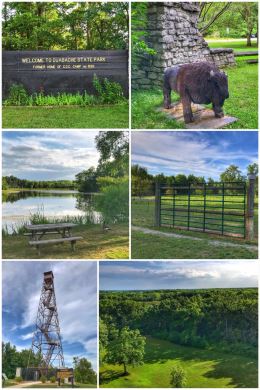
The 1,104-acre state park started its life in the 1930s as the Wells County State Forest and Game Preserve — and at one point, was the greatest producer of pheasant and quail chicks in the U.S. It became Ouabache State Recreation Area in the 1960s and, finally, a state park in the 1980s.
Ouabache is pronounced Wabash (as in the river)… which is how the French translated the Miami Indian word for the river, waapaahsiiki, meaning “water over white stones.” Besides the bike trail, the other main features include Kunkel Lake (a great fishing lake), a 100-foot former fire tower, the Ouabache Flatwoods Nature Preserve, and the Bison Exhibit (which houses a small herd of bison). The park also includes two campgrounds and several hiking trails.
The fire tower was one of 33 constructed by the state starting in the 1930s — and one of the few constructed in the northern part of Indiana. The lookouts — the people who monitored for wildfires — were often local farmers. By the 1970s, planes had replaced fire towers… and today, many fires are reported directly by nearby residents.
The Bison Exhibit is a 20-acre enclosure that generally houses 6-8 bison and is designed to educate folks that these amazing animals once roamed the the prairies of northern Indiana. (They also migrated to the southern part of the state for natural salt licks. By the early 1800s, the bison were eliminated from the state.
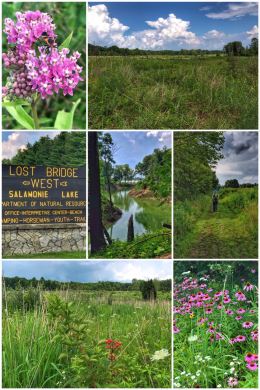
The next day, we traveled west about 25 miles to Salamonie Lake, Lost Bridge West State Recreation Area (SRA)… starting at the interpretative center just as the clouds opened and the rains came! Luckily, the rains were just an odd cluster that passed after about 20 minutes. We had fun exploring the gardens and then hiked the Turkey Cove Nature Trail (a .25-mile loop), followed by hiking part of the Bloodroot Trail (a 13-mile loop hike & bike trail) for about a mile — and then hiking several miles on the Kin-Ti-On-Ki Trail, named in honor of the Miami Indian’s name meaning “place of the eagles.” Other trails in this area of the lake include the Marsh Trail (1.25-mile loop), Tree Trail (1-mile loop), and Wildlife Management Trail (1-mile loop). The SRA also contains a modern campground (with power, bathhouse), two primitive campgrounds, and a beach and swimming area (open Memorial Day to Labor Day).
Besides where we explored, Salamonie Lake also includes Lost Bridge East SRA, Dora-New Holland SRA, Mount Etna SRA, and Mount Hope SRA — including a total of 12,554 land acres. Salamonie Lake (reservoir) itself is a 2,665-acre lake, constructed for flood control of the Salamonie River by the U.S. Army Corps of Engineers.
On the way back from hiking, we stopped at Two EE’s Winery, located in Huntington — about 24 miles northwest of Bluffton. The winery offers a nice mix of dry and sweet whites and reds, from grapes and other fruits. We did a flight of six samples for $5, and found the reds okay, but not quite our taste.
We then wandered down to the Indianapolis area, staying at a fairly nice RV park: Lake Haven RV Park, located just south of downtown. The park has nice facilities and we loved all the Canadian geese that live around the lake.
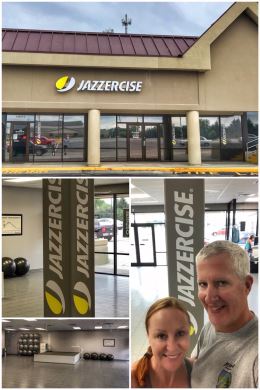
We also used this stop to get a Jazzercise fix, driving up to the Jazzercise Indianapolis Geist center, located northeast of the city.
We got a great workout from Kelley (who was a bit too enthusiastic about push-ups and planks) — and the facility is absolutely beautiful, with a cool floor, benches in the back, tons of hooks, and a water fountain that also has a bottle refill station.
While we enjoy the hiking and biking in nature, we also love the intense workout the Jazzercise provides — and for Jenny, also the great music and dance fix. While on the road, we also use hand-weights and a sit-up ball to keep as in shape as we can be while traveling full-time.
Afterwards, we hit another Costco (#1227) to get a few supplies — and get some cheap gas for the truck.

The next day, though, it was back in nature to hike some of the trails in Southwestway Park, the second largest park in Indianapolis. The 487-acre park is located off Mann Road, along the west bank of the White River, southwest of the city. The trails are used by hikers and mountain bikers, with some trails dedicated just to hikers. The trails are fairly narrow and travel through a variety of ecosystems. We hiked down to the river, where Ran gathered some river rocks for this collection… before the mosquitoes came out and we had to hike quickly back to the truck.
Southwestway Park also includes ball fields, soccer fields, and a playground. Plans are underway to add tennis courts and an aquatic center.
We ended our time in Indianapolis… no, not at the speedway, as we have no interest in racing… and not the zoo, as we prefer to see our animals in their natural settings… instead, we decided to do a bit of wine-tasting.
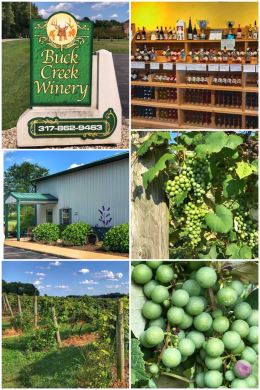
We had seen Buck Creek Winery as we drove into Indianapolis, so it only made sense to visit it on our last day in town. (It is the only commercial winery in the city.) Located about 13 miles southeast of downtown, with easy access of I-74, this winery offers a large variety (30+) of wines, from white to red and from dry to sweet. The only downside is that much of the dry wines were from grapes brought in from California. (On the plus side, the Lodi old-vine Zinfandel was amazingly fruit-forward and delicious!) You get 6 tastings for $5, with a few reserve tastings available for an additional fee; they also have discounts for multiple bottle purchases. And while the winery has only been open for a little more than a decade, Owner and Vintner Jeff Durm has been in the grape and wine business for many years, even making his own wines in his basement before starting this family-run venture. The vineyard, which has been around longer than the winery, has about 3,000 grapevines planted on just under 5 acres. We lefts with two bottles of their Zinfandel and one bottle of their X-Press (a wonderful blend). Here’s hoping they find a local source for more regional dry red wines.
We continued westward to Champaign, Illinois… entering our 27th state on this journey and reaching 52,000 miles of driving since we started this adventure — and about 19,000 miles so far in 2019. Illinois is, of course, the “Land of Lincoln.” Abraham Lincoln, our 16th U.S. President, started out his political career with four terms in the Illinois General Assembly (1834-1841).
We didn’t know it at the time, but Illinois is also one of the top five states for growing corn and soybeans… and it is indescribable trying to explain the the feelings of driving down a road and all you see is corn, corn, corn, and more corn. Illinois is actually second only to Iowa (and both states comprise the Corn Belt) for the number of bushels corn and soybean produced. Corn is the top crop in the state — and grown for use in ethanol and for animal feed. Like Indiana, pork is the top livestock — and the third most important agricultural commodity.
At one time, Illinois was also known as the “Prairie State,” but sadly most of that beautiful prairie has been tilled under for GMO corn and soybean crops. (The Illinois Farm Bureau estimates that about 90 percent of both crops grown in the state are GMO.) The state’s DNR (Department of Nature Resources) estimates that at one time about 13-million acres (about 60 percent of the state) were covered in prairie; today, fewer than 2,500 acres remain.
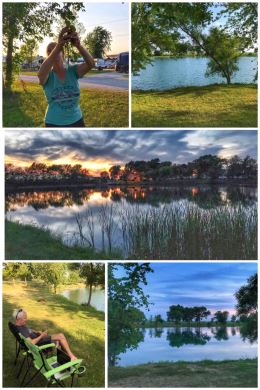
We stayed at another nice campground in Champaign: D&W Lake Camping and RV Park; it did not have the greatest facilities or WiFi, but it’s location and aesthetics could not be beat. (Amusingly, the campground is surrounded by farmland that alternates growing corn and soy.) We had an end spot (which we admit we covet) in a row next to the lake… and on two occasions, we brought our camping chairs down to the grassy shoreline and did our work sitting in the shade and enjoying the surroundings. We walked around the lake multiple times, but especially enjoyed the early-evening walks, when we marveled and rejoiced in the fireflies. The park is quiet and the staff friendly, and it is conveniently located off of I-57, just north of the junction with I-72. The owners of the park are third-generation, and while they have done some solid work keeping the campground a neat place, they should consider investing in upgrading the WiFi and making sure the bathrooms are in full working order.
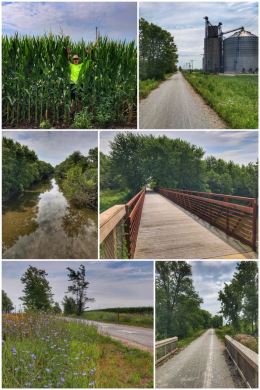
As we mostly do on this trip, we used the campground as a hub for exploring the surrounding area… this time starting our adventures with biking another rail-trail: the Kickapoo Rail Trail, which opened just two years ago. Starting at the Weaver Park Trailhead in Urbana, we biked the entire 6.7 miles that have been completed so far, turning around in St. Joseph. Eventually, the trail will run 24.5 miles — from Urbana to Kickapoo State Recreation Area, located in Oakland — following the former rail corridor of the Cleveland, Cincinnati, Chicago and St. Louis Railway, also known as the Big Four Railroad (and based in Indianapolis); it later became part of the CSX system. The crushed stone surface is great for all types of bikes. The section of the trail that is currently open travels through a part of what was once the Grand Prairie — covered in flowers and grasses that grew higher than 10 feet tall as far as the eye could see. (The Grand Prairie was part of a larger tallgrass prairie ecosystem that once covered much of the Midwest.) Herds of bison and elk, as well as other animals, fed among the prairie plants and found shelter in the timbers and groves that grew nearby; today, most of what we biked through were massive fields of corn. The current section crosses over the Salt Fork River (a once pristine river that is slowly recovering from farm and development runoff pollution), but when complete, the trail will cross three waterways: the Salt Fork River, Stoney Creek, and the Middle Fork River. It will also travel along multiple wetland areas. We even had our first introduction to Abraham Lincoln along the trail because as a young attorney, he rode a nearby route on horseback as part of being a lawyer for the 8th Judicial Circuit.
One interesting side note: The Kickapoo State Recreation Area is a 2,800-acre rehabilitated former turn-of-the-century surface mining operation that the state bought in 1939. It’s once stark surface mined banks are now covered with a forest of cottonwood, haw, ash, and wild cherry. It includes 22 lakes and access to the Middle Fork River… and has recreational activities for just about everyone: boating, fishing, mountain biking, hiking, camping, picnicking, hunting, and scuba diving — as well as winter sports.
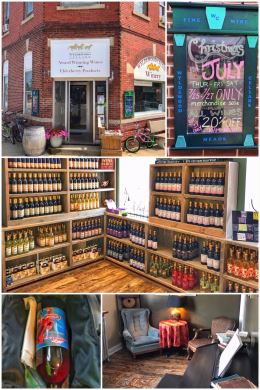
One other interesting side note: We discovered a great stopping point in St. Joseph: Wyldewood Cellars. When we saw the winery on Google Maps, it seemed so familiar — and it turns out, it is! We met with Tracie, the owner of the winery (which opened about 7 years ago), who explained that the original Wyldewood Cellars is located in Kansas — started by her dad, Dr. John Brewer 23 years ago. We visited that winery in May while we were traveling through Kansas. Tracie learned the business from her father and when she and her husband moved to Illinois, they started this winery. The cool part is that Wyldewood focuses on making wines from elderberry and a few other fruits (including peach, blueberry, cranberry, and blackberry)… why wines ranging from dry to sweet. You can taste a few of the wines for free, but have to pay $5 for a more full tasting (per state law). Since we were biking, we decided to just taste a few. We enjoyed several of the dry elderberry, but completely fell in love with the Cardinal Red, a dry wine made from Muscadine grapes (which we had not had since Arkansas).
As we left with a bottle of the Cardinal Red — on our way back to completing our 15-mile bike ride — we discovered something wonderful and a little dangerous… Ran’s new bike pack can very nicely fit two bottles of wine. Perhaps we will be doing a bit more biking to wineries later in the trip! (We did do one round of biking to wineries in Lodi last year.)
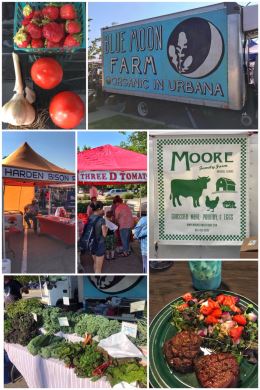
The next day, we got up early to enjoy one of our other favorite activities of the summer months… checking out the local farmers market: Urbana’s Market at the Square, located at the corner of Illinois and Vine takes place every Saturday morning between May and October.
With 10 rows of vendors — including food trucks — the market was much bigger than we expected… and we loved it! We picked up some organic greens and garlic at Blue Moon Farm, pastured pork loin and jumbo eggs from Moore Family Farm, fresh tomatoes from Three D Tomatoes, and bison steak from Harden Bison Ranch.
After getting all those goodies, we then went next door to Common Ground Food Co-Op, where we picked up some local micro-greens, as well as organic buttermilk and sour cream (for a new batch of Ran’s Ranch Dressing), as well as our favorite Green Valley Creamery Organic, Lactose-Free cream cheese.
We finished the evening with some pastured, grass-fed and grass-finished filet mignons we had purchased weeks ago from our wonderful rancher, Paul, of Misty Meadows Farm in Minnesota… along with a salad with fresh ingredients from our morning at the farmers market. We said a special prayer for all these farmers and ranchers bucking Big Ag and Factory Farming.

The next day we hiked through Busey Woods. This 59-acre bottomland Oak-Hickory-Maple forest was saved from development and dumping. (One section of trail goes by a large collection of dumped concrete pieces.) It is the last preserved section of the Big Grove, a 10-square-mile forest that once took up most of northern Urbana — a rare forest amidst the vast tallgrass prairie of the area. Multiple hiking options are available within the woods, starting with a looping elevated boardwalk. We took one of the dirt side trails off the boardwalk and were very happily delighted to hike upon a doe and her two fawns along the trail.
Busey Woods is located at the north end of Crystal Lake Park, with an entrance just west of the Anita Purves Nature Center — which is also a fun place to visit, for all ages. We spent some time in the birding observation room (including have a visit from its resident woodchuck), the animal area (which includes three rescued owls, as well as turtles and snakes), and a tiny little gift shop. The center also has clean bathrooms. (And yes, that is Jen kissing a big frog statue after our hike.)

We ended our time in the Champaign/Urbana area with a wonderful hike in the Lake of the Woods Forest Preserve, located about 10 miles to the west in Mahomet, along the corridor of the Sangamon River. The 900-acre preserve includes the Museum of the Grand Prairie, Mabery Gelvin Botanical Garden, Lake of the Woods Golf Course, and multiple trails, including a 3.3-mile paved bike path. Our focus was specifically in the Buffalo Trace Prairie, which the bike path runs through… but we were hiking and so opted for 2.6-mile outer loop trail. (Other trails range from 2 to 5 miles.) Purchased in 1976 and converted from farmland back to prairie, the Buffalo Trace Prairie is named for the bison that used to roam the area while migrating.

The next day we then continued our counterclockwise travel, leaving the Champaign area and heading for Peoria, Illinois, staying at a campground along the Illinois River. Millpoint RV Park is a pretty mellow and very-treed campground, but park management is perhaps a bit too laid back, and while they are making some improvements, they need to upgrade the electrical and WiFi… and perhaps have more than two individual bathrooms. That said, the location cannot be beat, and we walked several trails down along the river… a principal tributary of the Mississippi River, and approximately 273 miles long; the river is formed by the confluence of the Kankakee River (which we visit in our next stop) and the Des Plaines River. Peoria is the chief city on the Illinois River.
Peoria is the second largest city in Central Illinois after the state capital, Springfield. It is named for the Peoria tribe, a member of the Illinois Confederation. Until 2018, Peoria was the global and national headquarters of Earth-moving manufacturer Caterpillar, which stills offers tours. The city is associated with the phrase “Will it play in Peoria,” which originated during the Vaudeville era and was later popularized by Groucho Marx.
Peoria also has a zoo, museums, and parks. It also has Grandview Drive, which runs for about 2.5 miles through Peoria and Peoria Heights — offering scenic views of the river and some of the most prestigious and historic homes in the area.

Another benefit to Peoria: It has a great Jazzercise location, which was located just a few miles south of our campground: Jazzercise East Peoria Fon Du Lac Park Administration Center.
We had a wonderful Dance Mixx workout, with a solid selection of dancing, weights, and standing crunches mixed with fun music.
While we love being outside — whether hiking or biking — sometimes you just need to push that heart rate with some intense dancing. Plus, mixing up your exercise routine uses more muscles; plus, who doesn’t like diversity? Whatever works for you — just keep moving to keep yourself as healthy as possible.
Peoria — or more specifically, East Peoria — also has a Costco (#1126) … so we took advantage by stopping there twice to fill up on gas and do a little shopping in the store.
We had a couple of options for hiking and biking in Peoria, but changed our plans slightly when we realized Jenny had a friend in Springfield… and we could go visit her while learning more about our 16th President.

While Abraham Lincoln was not born in Springfield, he spent several years living there, from 1837 to 1861, getting married and having children, building his law practice, and honing his skills as a politician and statesman… before being elected president in 1861, serving until his assassination in April 1865.
We love Lincoln because he believed in the ideal that everyone in America should have the opportunity to improve his/her economic and social condition.
We started at the visitor center, where we paid the parking fee and picked up our free tickets to the next guided tour of the Lincoln House — the only house Lincoln owned, and which he bought (with wife Mary Todd) in 1844. (Lincoln’s only surviving son, Robert Todd Lincoln, donated the family home to the State of Illinois in 1887.) The tour was fun — and includes both the main and upper floors — and includes some original furniture and features of the house. The home sits in a 4-block area of other restored and historic homes that surrounded the Lincolns. After walking the “neighborhood,” we went back to the visitor center and watched the film, Abraham Lincoln: A Journey to Greatness — as well as going to the gift shop and picking up a magnet and a silk Lincoln-inspired tie for Ran.
We also had to share a few favorite quotes from Abraham Lincoln: “Character is like a tree and reputation like a shadow. The shadow is what we think of it; the tree is the real thing.”
Another great quote — and so true today with so much rancor in Washington, DC, and so much denying of climate change and other environmental issues: “My dream is of a place and a time where America will once again be seen as the last best hope of Earth.”
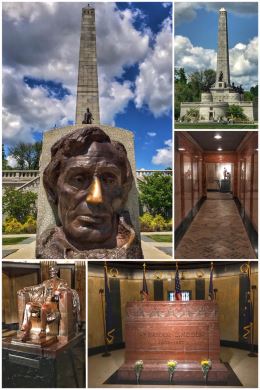
Our next stop was visiting the Lincoln Tomb State Historic Site, just north of downtown, the final resting place for Lincoln, his wife, and three of his sons. (Robert Lincoln is buried in Arlington National Cemetery.) It sits on a 12.5-acre plot in Oak Ridge Cemetery.
Designed by sculptor Larkin Mead, the Lincoln Tomb is constructed of brick sheathed with Quincy granite. The base is 72 feet square with large semi-circular projections on the north and south sides. Double sets of stairs lead to a terrace, above which rises the 117-foot-tall obelisk. It has been renovated several times over the years for structural and security measures.
The interior of the tomb is done in highly polished marble trimmed with bronze and contains reduced-scale versions of important Lincoln statues, as well as plaques with excerpts from Lincoln’s farewell address to Springfield, the Gettysburg Address, and his Second Inaugural Address. President Lincoln’s remains rest in a concrete vault ten feet below the marble floor of the burial chamber — with the family members located in crypts directly across.
In front of the Lincoln Tomb is a bronze reproduction of Gutzon Borglum’s marble head of Lincoln, whose nose everyone seems to rub for good luck, as seen in the photo.
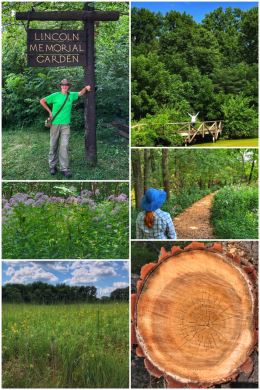
We end our Day of Lincoln with a visit to the Lincoln Memorial Gardens located just south of town, a 100-acre park filled with woodlands (including the White Oak, the state tree) and prairie, some of which borders Lake Springfield — a reservoir. It is owned by the city of Springfield and managed by the Abraham Lincoln Memorial Garden Foundation.
And we discovered something that made us love and appreciate President Lincoln even more… he was an early forest bather… someone who seeks refuge and recharging in woodlands. As a lawyer, Lincoln traveled extensively through the Illinois prairies, and he sought out shady areas along the way to rest, relax, and contemplate.
Along the 5 miles or so of walking/hiking trails are benches with quotes from Lincoln… thus, another quote we liked: “Whatever you are, be a good one.” We basically hiked from the Nature Center toward the lake and then westward to the Ostermeier Prairie Center — and back.
Later in the day, we met for coffee with one of Jen’s old friends who now lives in Springfield. Certainly one of the extra fun we have had on this trip is meeting up and reconnecting with friends we have not seen in years. We were told that Springfield is not the safest of cities and were happy to hear that information at the end of the day, as we were heading back to our safe little campground in the woods rather than when we were deciding whether to even visit Springfield!
That said, the Springfield area does have a lot to offer — including more Lincoln stuff like the Abraham Lincoln Presidential Museum, Abraham Lincoln Presidential Library, and Lincoln’s New Salem State Historic Site, Lincoln-Herndon Law Offices. It also includes several museums and historic sites. Springfield also has the Illinois State Capitol and Governor’s Mansion. For Route 66 fans, the historic Mother Road goes right through the heart of Springfield.
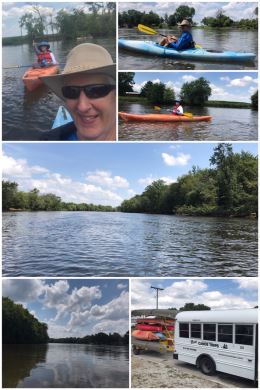
We next traveled to our last stop in Illinois, staying at a KOA near Kankakee — so that we could take advantage of being near the Kankakee River. The 133-mile river is a tributary of the Illinois River (along which we had just previously camped) and once drained a major wetlands, but was first diverted to cultivate cropland for corn and soy and later channelized in portions to help the floating of logs from the harvesting of trees from the former marsh area.
We once again took advantage of a kayaking opportunity — to kayak about six miles down the river to a point just before the Kankakee conjoins with the Iroquois River. We used Reed’s Canoe Trips to rent the kayaks and transport us to and from the river portages.
Kankakee is a fairly large city — about 26,000 population — with a strong base of industry and manufacturing… which makes sense given its location near Chicago and strong transportation connections. The name, as you might guess, comes from the Miami-Illinois word teeyaahkiki, meaning “land in open/land exposed to view” — in reference to the area’s prior status as a wetlands/marsh along the river before the river was diverted.
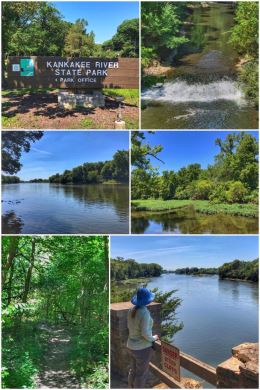
The next day, we continued our exploration of the river by visiting the Kankakee River State Park, located about six miles northwest of town. The 4,000-acre park surrounds about 11 miles of the river and offers just about all recreational activities, including canoeing, fishing, hunting, biking, hiking, horseback riding, camping, and picnicking — plus snowmobiling and cross-country skiing in the winter.
We started at the park’s main entrance along Route 102 and checked out part of the 10.5-mile paved bike trail while walking to the view the river. We had thought of bringing our bikes here, but were more in a mood for a hike, so after viewing the river, we crossed over to the east side of the park to attempt to hike both the Rock Creek Trail and the Chief Shaw-waw-nas-see Nature Trail… which resulted in a 4.7-mile hike. The highlights of the Rock Creek Trail include a view of Horsethief Cave (which one can view from an overlook and/or scramble down to the creek for a closer view; we did both) and a small waterfalls. The interconnected Chief Trail is not nearly as well marked, especially if one hikes it clockwise rather than counterclockwise. The highlights of the trail include a nice section along the creek and the grave marker for Chief Shaw-waw-nas-see, of the Potawatomi, who decided not to leave the are when the last of the tribe left the valley.
From Kankakee, we crossed back into Indiana to the South Bend area… mainly its location near Indiana Dunes National Park, which will be the subject of our next blog post (Stop 98).
Our other goals in the South Bend area involved stocking up on organic foods, visiting a local rancher, taking another Jazzercise class, and something really fun and crazy — attending a HEART concert, featuring Elle King and Joan Jett and the Heartbreakers… at their Love Alive Tour.

We found another great Jazzercise studio in South Bend: the Jazzercise Mishawaka Fitness Center (which is located in the South Bend Racquet Club on Hickory Road. (The studio is actually the result of transforming two racquetball courts. A very cool setup.) We loved the floors — and the cool purple colors of the studio.
Our first visit was a Flip Fusion class with Karen, which was an amazingly powerful and fun workout… and we both left drenched in sweat! We enjoyed the workout so much, that we decided to squeeze one more session before we left South Bend, just making it in time to Melissa’s Dance Mixx workout. We again left drenched and happy, and greatly appreciated the opportunity to get in two sessions.
While in South Bend, we also visited the historic South Bend Farmers Market, but because it was a Tuesday, there were not as many vendors. It was a fun experience, though, and we were able to pick up some fresh string beans, a tomato, and some more interesting cheeses. (We were hoping also for some salad greens and other goodies, but had no success.)
We did have some success at Whole Foods and Down to Earth, two organically-focused stores, where we restocked with our Zevia sodas, Green Valley cream cheese, Organic Valley cream cheese, Applegate Naturals turkey pepperoni, and a bunch of organic produce. We also had to check out another Costco (#1183) and get our macadamia nuts.

But the best part of being in this area was a trip to Bennett Farms, just across the state line in Edwardsburg, Michigan… where Tom Bennett, a Marine veteran, humanely raises superior quality pork and poultry on green pastures in a sustainable way; and their animals are antibiotic, hormone, and GMO free. (Tom actually attends the South Bend Farmers Market, but only on Saturdays when the foot traffic is high enough to provide a profit.)
Tom was kind enough to give us a tour of this farm… where he raises pigs, chickens, and turkeys (seasonally)… he raises both eat chickens and laying chickens (and sells fresh eggs too). In the warm season, the chickens are raised in mobile chicken pens that are moved through one of the pastures often, so the chickens constantly get fresh pasture and grubs.
The pigs are raised completely outside in rotating temporary pastures and given supplemental (protein) non-GMO feed… and include heritage breed and heritage cross bred pigs suited for life outside. (His main male is a Mulefoot hog.)
One other element about Tom we valued and appreciated — he is a veteran, having served nine years in the U.S. Marines. His website proudly displays that his products are part of the Homegrown by Heroes, part of the Farmer Veteran Coalition… and there is no better way to support our veteran farmers and ranchers than by buying their products — especially the way Tom does it… non-GMO and sustainably.

We ended our days in Indiana with a trip down to Noblesville and the Ruoff Home Mortgage Music Center (originally the Deer Creek Music Center), the largest outdoor amphitheater in the Indianapolis area — with 6,147 seats, under a pavilion and 18,000 general admission lawn seats.
We splurged in multiple ways… first in purchasing a ticket package that included close-to-the-stage seats AND a meet and greet photo opportunity for Heart headliners, Ann and Nancy Wilson — the sisters who are truly the heart and soul of Heart. The band is currently on a nationwide tour entitled the “Love Alive Tour.” While the location of the concert was a bit out of our way, we could not pass up seeing the band when we learned we were going to be in the area. In fact, one of our goals of the trip has been to see live music, but we have only been fortunate to find it a few times on the trip. (We also splurged on a nice hotel for the evening rather than attempting to drive back to the campground after the concert.)
The highlight of the event had to be the short, but sweet photo meet and greet with Ann and Nancy. While we were a bit rushed (and told not to attempt to ask them to autograph anything), it was still a very cool experience to meet with such legendary musicians. Jen really admired Ann Wilson for her vocals, while Ran admired Nancy for her mastery of multiple instruments (and her vocals). Heart has sold more than 35 million records worldwide since forming in 1973, and have had a top 10 album (according to Billboard) in four different decades! They were inducted into the Rock and Roll Hall of Fame in 2013.
Some of the bands best known songs include: Love Alive, Magic Man, Alone, Barracuda, Dreamboat Annie, These Dreams, Crazy on You, Straight On, Dog & Butterfly, All I Wanna Do is Make Love to You, and What About Love?
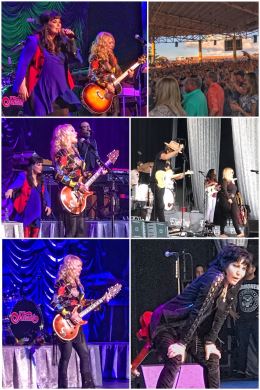
The lineup for the concert could not be beat either… besides Heart, it included Elle King and The Brethren and Joan Jett and the Blackhearts… so lots of strong female singers — one just starting out and the others mature performers. Elle King performed for about 30 minutes, while Joan Jett played about a 45-minute set. Heart played about a 2-hour set. Overall, it was a solid concert, though Joan Jett may have performed the best set.
Joan Jett & the Blackhearts have also been inducted into the Rock and Roll Hall of Fame (in 2015). Elle King released her debut album in 2015.
Overall, it was a great evening of fun and inspiring (and in some cases, nostalgic) music. We also enjoyed all the people-watching… and we extremely happy we remembered to bring our ear protection.
The one downer of the evening is that LiveNation did NOT plan the photo opportunity well… which meant we missed most of Elle King waiting in line for Ann and Nancy Wilson to arrive at the designated location. We did hear most of Elle King’s performance, but it would have been nice to have the photo shoot earlier — or at least have a monitor so that we could watch some of the performance.
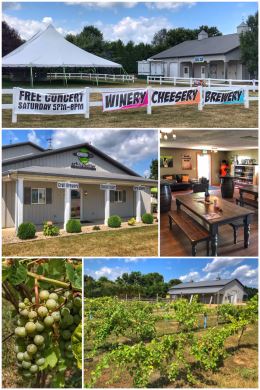
We ended our Indiana experience with a stop at a fun little winery in Rochester, on the way back to our campground. To be honest, Schnabeltier is more than a winery… it also makes cheese and cider.
Schnabeltier is the German word for platypus, which is an animal made up of many different parts to create a unique whole. The founders of
Schnabeltier thought the name was fitting since it is the only known facility to focus on beer, cheese and wine production under the same roof. They talk about sourcing locally — and their cheeses most certainly do using milk from Lemler Farms (Bourbon, Indiana) — but their wines, especially their dry wines, use grapes sourced from California, Washington, and even Chile. You can sample their cheeses while also sampling their wines (or beers). Wine samples are $1 per taste. We really liked their Loyal Gouda cheeses and left with three of their unique flavors, including morel mushroom, firecracker, and
But we found their wines to be just okay and didn’t buy any. Of course, like most Midwest wineries, their top wines are the sweet wines, which are way too sweet for us. We have been kind of disappointed in the Indiana wineries we have visited who do not use local grapes for their dry wines, but to be fair, most of them are simply catering to their current customers — who like sweet wines.
Next up — after the post about Indiana Dunes National Park — is a visit through Ohio as we push eastward… and another national park!
